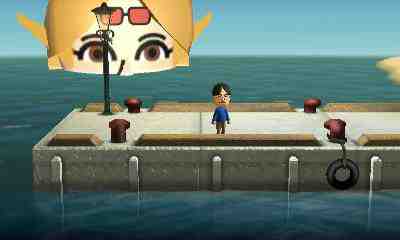If you thought Nintendo's WarioWare games were bizarre, prepare to enter a whole new level of weird with Tomodachi Life. In Nintendo's most surreal handheld game yet, Tomodachi Life sees you populating an island full of Mii characters and then watching them live out their strange little lives as you clothe and feed them, play cupid and generally cater for their every need.

Miis don't make friends automatically - you'll need to help them along and introduce them to their new neighbours
It sounds like your average life sim, but Tomodachi Life is anything but ordinary. By giving you free reign to use your Miis (either by creating them from scratch, importing them from your Mii Plaza or scanning in ready-made characters using QR codes), the game throws all pretence of realism to the wind and gives you the freedom to create some truly wacky characters, whether it's the entire cast of Doctor Who, The Legend of Zelda or the minions from Despicable Me. With entire sites dedicated to curating the very best Mii QR codes (www.miicharacters.com is particularly good), we're sure you'll find some interesting characters to place in your new island.
Using your Miis in a game isn't a new idea, though. Several Nintendo games give you the option of using a Mii character, but Tomodachi Life goes one step further by giving them their own personality. By adjusting their energy levels, mood, overall uniqueness, how expressive they are and how quickly they speak, you can assign each Mii one of sixteen distinct personality types.

The Photo Gallery is another great addition, letting you pose your islanders in a variety of shots that you can save to your SD card
They're also given a voice courtesy of an adapted version of the game's original voice synthesiser. The voice synthesiser is a work of art in itself, but it also adds yet another layer of kooky personality to your Miis and the tone of the game. Choosing a Mii's voice never gets old either, whether it's hearing arch Zelda villain Ganondorf mumble in the lowest of bass tones or hearing Angelina Jolie squealing away like a chipmunk on helium.
Once your Miis are ready to go, they each take up residence in one of 24 apartments on the island. These can be decorated with new interiors and filled with various treasures you'll discover throughout the game, but Tomodachi Life is more about provoking odd reactions from your Miis than playing dress-up. For example, upon feeding one of our Doctor Who companions a plate of spaghetti carbonara, she loved it so much that her feet suddenly turned into rockets and she jetted off into space.

Rose was so happy with her carbonara that she literally exploded with joy
Likewise, stumbling upon a Mii's dream gives a new level of meaning to word 'surreal'. So far, we've tapped into Satoru Iwata freaking out over a giant Princess Zelda head rising up from the sea and Ganondorf racing ourselves and Amy Pond as anthropomorphised snails to name but a few. It's so strange that you'll want to try out every possible avenue to can to see what level of weirdness the game will take you to next.

Even Nintendo's creepiest games haven't got anything on Tomodachi Life's bizarre dream sequences
Waiting for those moments of whimsy can be a bit draining, though, as you'll need to catch your Miis at just the right moment for anything to happen. If they're just sitting (or indeed rolling) around in their room perfectly content or moseying around one of the island's many unlockable locations, then there's little you can do except feed them or give them more presents if they're in their room, or watch them from afar if they're outside. Wait a few minutes and they're bound to want you for something sooner or later, but it can feel a little disengaging when you're often left twiddling your thumbs for five minutes.
When your Miis do want your attention, it's often to play tiny WarioWare-style micro games. Sadly, these possess none of WarioWare's innate eccentricity and are often simple "guess the correct image" games or "grab falling items" using the touchscreen. They're a fun distraction, though, and if you complete the game successfully, you're awarded a prize which you can then give back to your Miis later.
The Concert Hall is by far the best place to go on the island, but other venues such as an amusement part and observation tower gradually open up as you play more of the game
Playing with these prizes is actually a lot more fun than the games themselves and many of the ensuing results do in fact hark back to WarioWare's unique sense of whimsy. A hypnotism set will let you view all the dreams you've unlocked, for instance, while a kaleidoscope will use the 3DS's gyroscope to create patterned combinations of your Miis and their favourite foods.
All these activities are important for increasing your Mii's overall happiness. Here, Tomodachi Life employs a few light RPG elements to give the game a bit more structure, as levelling up a Mii's happiness lets you give them additional skills, such as catchphrases and songs to sing in the island's concert hall (the latter of which is easily the best and most comic part of Tomodachi Life), and special treasure items which they can then use in their apartment permanently. Happy Miis also means more pocket money for you to spend on them each day, so it's in your best interests to keep them entertained if you want to try out lots of new food and items on them.
Give your Mii a special item and you'll eventually see them using it in their apartment
The game doesn't just want you to fawn over individual Miis, though, as they can also form relationships with each other and even get married and have children. While Nintendo's faced much criticism over not allowing gay relationships in the game during recent weeks, the sheer randomness of how each relationship is formed actually gives you very little control over who dates who. So far, our own Mii character has married the Tenth Doctor, Ganondorf is going out with Angelina Jolie and Link and Shigeru Miyamoto are best mates. Still, regardless of whether they end up as special someones or best friends, we'd be lying if we said we didn't always feel a certain amount of glee in seeing who ends up with who.
Tomodachi Life's only problem is just how much it relies on novelty to fuel its appeal. A lot of its charm lies in that initial first glimpse into its weird and wonderful imagination, but once events start repeating themselves, the game loses a lot of its staying power. We're sure that social networks will go into overdrive over the next few weeks as players share their own screenshots of the game via the Image Share feature – particularly as you can take screenshots of both screens with the X and Y buttons rather than just the top screen like Animal Crossing: New Leaf – but unlike New Leaf, there's much less on the horizon to keep players coming back for more once the game's honeymoon period starts to wane. This wouldn't be so bad if Tomodachi Life was a cheaper, download-only title, but as a full-priced game it feels a little lacking compared to New Leaf's immense amount of replayability.
Miis can get married and have kids if you help them propose at the right time
Still, Tomodachi Life certainly gets points for its unique sense of humour, and its added self-awareness only adds to the game's attraction. If anything, it's a Nintendo fanfiction writer's dream game, and we'd heartily recommend giving it a go if you like your games strong on surreal comedy.
Details | |
|---|---|
| Price | £30 |
| Details | www.nintendo.co.uk |
| Rating | **** |






Leave a Reply